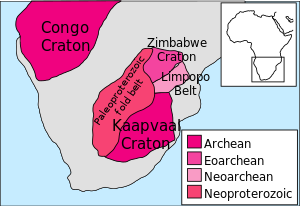Geology of Zimbabwe

ISS
, 2010.
The geology of Zimbabwe in southern
ultramafic/mafic igneous complex known as the Great Dyke which runs for more than 500 km along a SSW/NNE oriented graben. It consists of peridotites, pyroxenites, norites and bands of chromitite.[2]
Stratigraphy
Precambrian
The oldest
By 1982, 123 mines had produced 155 tonnes of gold from the
Units had produced 400 and 161 tonnes respectively. Granitoid host rocks had produced a total of 132 tonnes of gold, and include the Rhodesdale Batholith at 53 tonnes, the Sesombi Suite at 36 tonnes, and the Penhalonga quartz diorite at 10 tonnes.[3]
Economic geology
Zimbabwe's mineral resources include, amongst others,
chrysotile asbestos and vermiculite. Gold, platinum group metals and chromium are Zimbabwe's key mineral resources. The Great Dyke provides most of Zimbabwe's chromium reserves. Zimbabwe experienced a decline in the mining of many minerals in the period to 2008 including the closure of several gold mines. However, diamond production increased making the country Africa's seventh largest producer by 2008.[5]
The country has considerable coal reserves which are used in power generation. Its
coal-bed methane field, the largest in southern Africa has not yet been exploited to the full.[6]
See also
References
- .
- ^ "Zimbabwe, geology Extractive Industries Source Book". Archived from the original on 2013-03-02. Retrieved 2013-04-20.
- ^ ISBN 906191504X.
- ISBN 906191504X.
- ^ "Zimbabwe, mining Extractive Industries Source Book". Archived from the original on 2013-03-02. Retrieved 2013-04-20.
- ^ Zimbabwe, oil and gas Extractive Industries Source Book
External links
Wikimedia Commons has media related to Geology of Zimbabwe.
